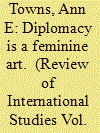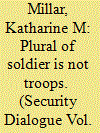|
|
|
Sort Order |
|
|
|
Items / Page
|
|
|
|
|
|
|
| Srl | Item |
| 1 |
ID:
176493


|
|
|
|
|
| Summary/Abstract |
The aim of this article is to examine whether and how diplomacy may be gendered, symbolically and rhetorically, using US representations of diplomacy as a case. Prior scholarship on gender and contemporary diplomacy is sparse but has shown that the symbolic figure of ‘the diplomat’ has come to overlap tightly with ‘man’ and be associated with traits often attributed to masculinity. Inspired by queer international relations methods, relying on the concept of ‘figuration’ and focused on US news media and biographies of diplomats from the past decade, this article uncovers and examines a palette of feminised figurations also at play in US representations of diplomacy, including the diplomat as ‘the “soft” non-fighter’, ‘the relationship builder’, ‘the gossip’, ‘the cookie-pusher’, and ‘the fancy Frenchman’. These feminised figurations alternate between configuring the diplomat as a woman and – more commonly – a (feminised) man. The analysis complicates rather than displaces existing claims, highlighting the importance of attention to slippages and challenges to dominant masculinised subject positions.
|
|
|
|
|
|
|
|
|
|
|
|
|
|
|
|
| 2 |
ID:
165897


|
|
|
|
|
| Summary/Abstract |
This article identifies ‘the troops’ as a new, radically under-examined figure in the Western canon of war. Utilising discourse analysis of an original corpus of US ‘support the troops’ material from 2001 to 2010, the article argues that ‘the troops’ cannot be read as a simple aggregation of the figurative soldier or literal military personnel. Instead, ‘groupness of the troops’ shifts the politics of the legitimation of violence – and the possibility of meaningful dissent – in two distinct ways. Firstly, ‘the troops’ are figured, counterintuitively, as passive, dependent and at risk of suffering harm. This enables constructions of militaristic, heroic violence to coexist with empirical experiences of vulnerability without ideological contradiction. Secondly, though many accounts of militarism rely upon citizens’ aspirational identification with the ostensibly-universal soldier, the ‘groupness’ of the troops enables them to incorporate, rather than elide, substantive differences (e.g. race, gender or sexual orientation) through an all-encompassing relationship of ‘support’. Consequently, ‘the troops’ may be a more effective avatar of militarism than ‘the soldier’ – and far more important to the legitimation, depoliticization and even perpetuation of conflict than previously realized. What would the politics of military involvement in Afghanistan and Iraq have looked like absent the ‘escape valve’ of the figurative troops?
|
|
|
|
|
|
|
|
|
|
|
|
|
|
|
|
|
|
|
|
|